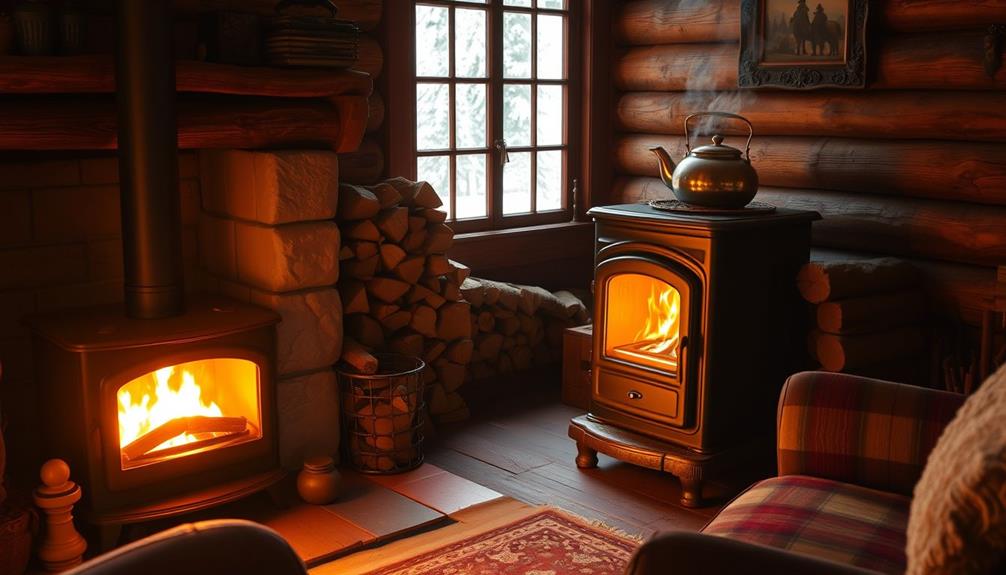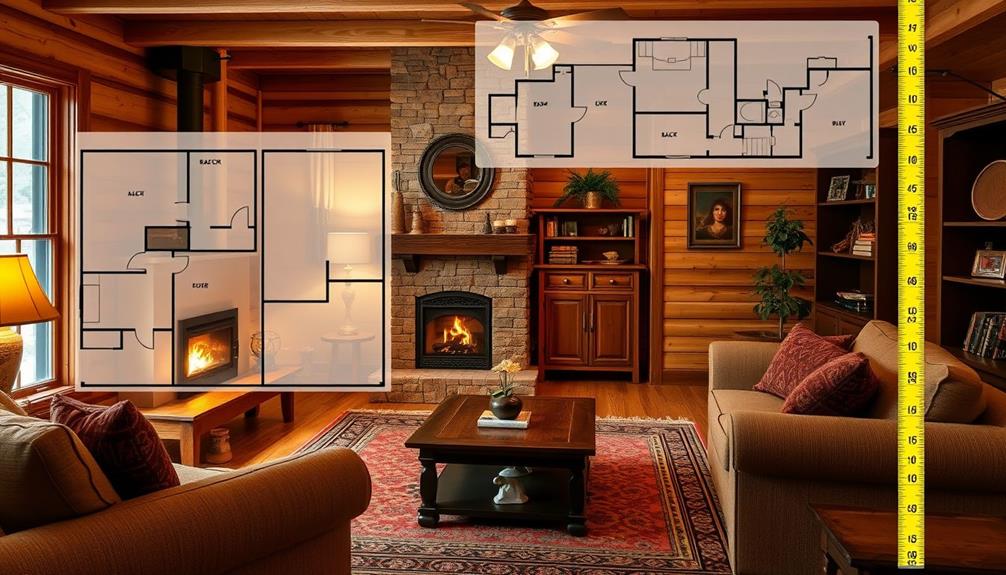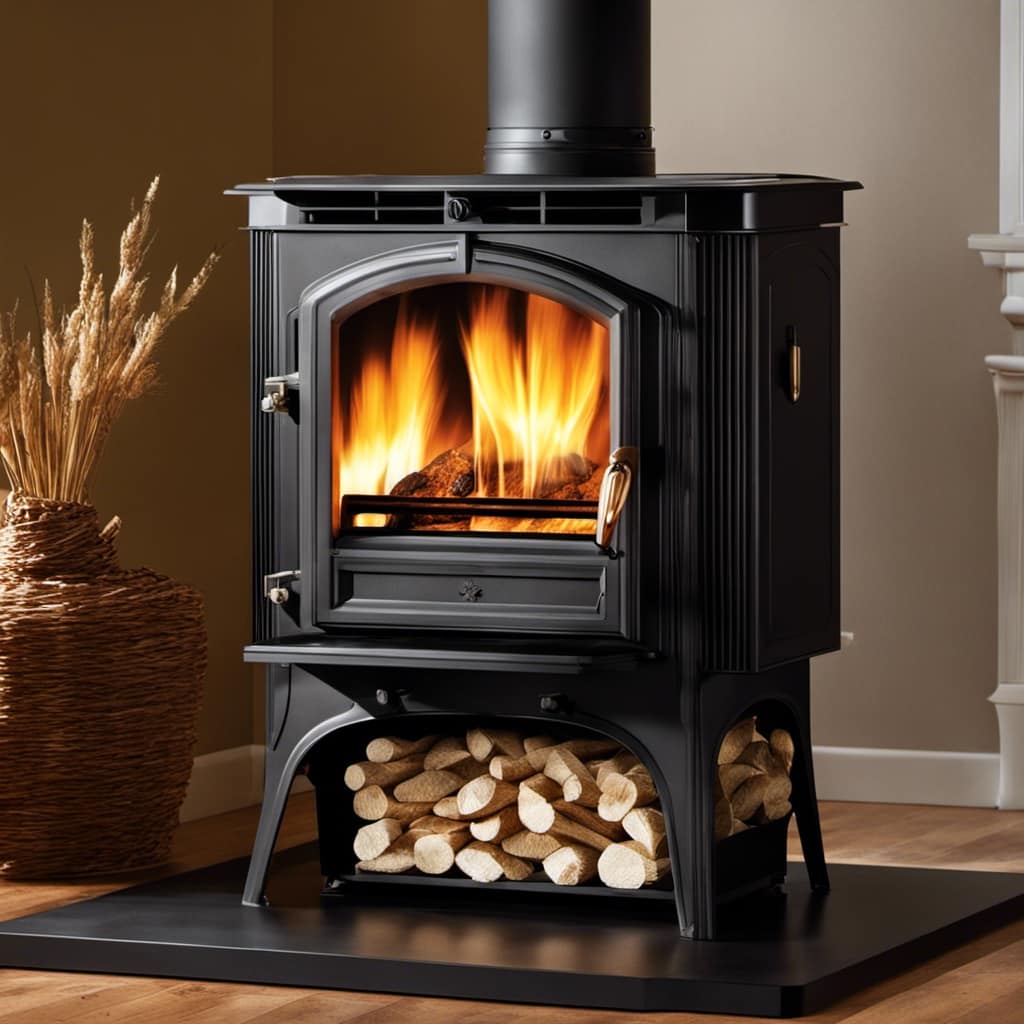To use your wood stove efficiently, start by using seasoned wood with less than 20% moisture, which burns hotter and produces less smoke. Maintain a combustion zone temperature of at least 600°C (1,100°F) for peak performance. Employ the top-down method for starting fires and limit log additions to five at a time for better airflow. Regularly clean your stove and chimney to prevent creosote buildup, and verify smoke detectors are installed for safety. Following these practices can help you maximize heat while minimizing emissions, and there's even more to discover about enhancing your wood stove experience.
Key Takeaways
- Use seasoned wood with less than 20% moisture content for more energy and a hotter fire.
- Start fires using the top-down method for longer burns and reduced smoke.
- Maintain combustion zone temperatures at or above 600°C (1,100°F) for optimal performance.
- Conduct annual chimney inspections to prevent creosote buildup and ensure safe operation.
- Install smoke and carbon monoxide detectors near the stove for early hazard detection.
Understanding Wood Stove Efficiency
Understanding wood stove efficiency is fundamental for getting the most out of your heating system. Efficient wood burning stoves can reduce fuel consumption by up to 30% compared to older models, thanks to advanced combustion technology and design.
For instance, the BTU rating of the Englander 10-Cpm Corn Wood Pellet Stove shows how modern stoves can generate significant heat while maintaining efficiency. To achieve this efficiency, it's important to maintain a combustion zone temperature of at least 600°C (1,100°F). This temperature helps prevent smoldering and guarantees efficient combustion, resulting in cleaner emissions and a reduced environmental impact.
One key to maximizing your stove's efficiency is using seasoned wood, which has a moisture content below 20%. This type of wood burns hotter and provides up to 12% more energy than fresh-cut wood. Additionally, high-efficiency stoves utilize prewarmed combustion air, further enhancing their performance.
Regular maintenance is also critical for peak efficiency. Make sure to clean the flue and check gaskets regularly to prevent creosote buildup, which can hinder your stove's performance.
Importance of Seasoned Wood
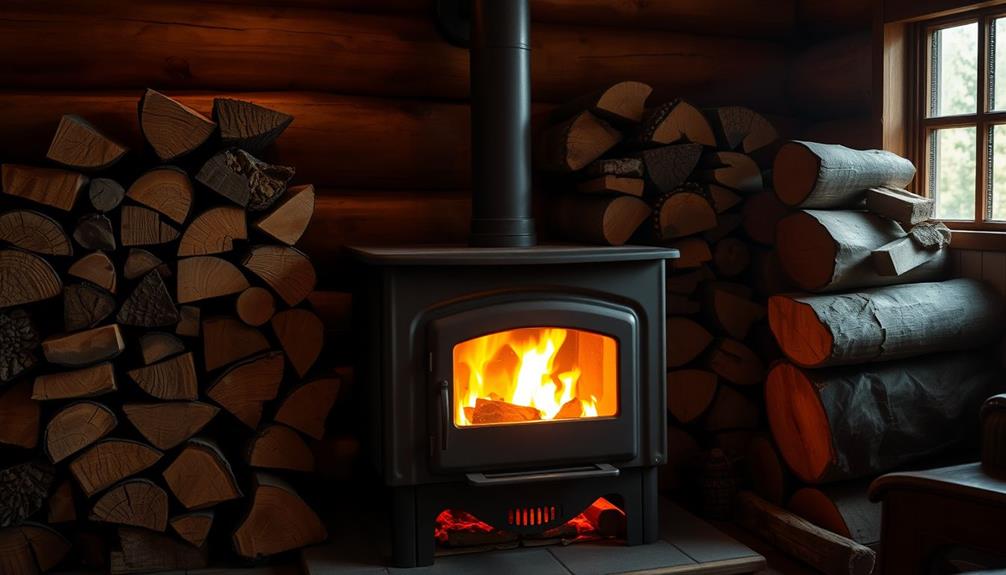
Using seasoned wood is essential to maximizing the efficiency of your wood stove. Seasoned wood, with a moisture content below 20%, burns much more effectively than fresh-cut wood. In fact, it provides about 12% more energy, allowing you to enjoy a hotter, longer-lasting fire. This means you'll need to reduce the amount of wood you burn, saving you both time and money.
Additionally, understanding the impacts of credit card trends can help you manage your finances better when investing in quality wood.
Properly seasoning your wood takes time; it typically requires at least six months to one or two years of drying, depending on the type. Hardwoods like oak and maple are great choices because they burn longer and hotter, enhancing your stove's performance.
Additionally, burning seasoned wood produces considerably less smoke and harmful emissions, which helps maintain better air quality and reduces creosote buildup in your chimney.
It's also vital to use only untreated and unpainted wood to avoid releasing harmful chemicals into your home. By prioritizing seasoned wood, you're not just making your wood stove more efficient; you're also contributing to a healthier environment.
Operating Techniques for Optimal Heat
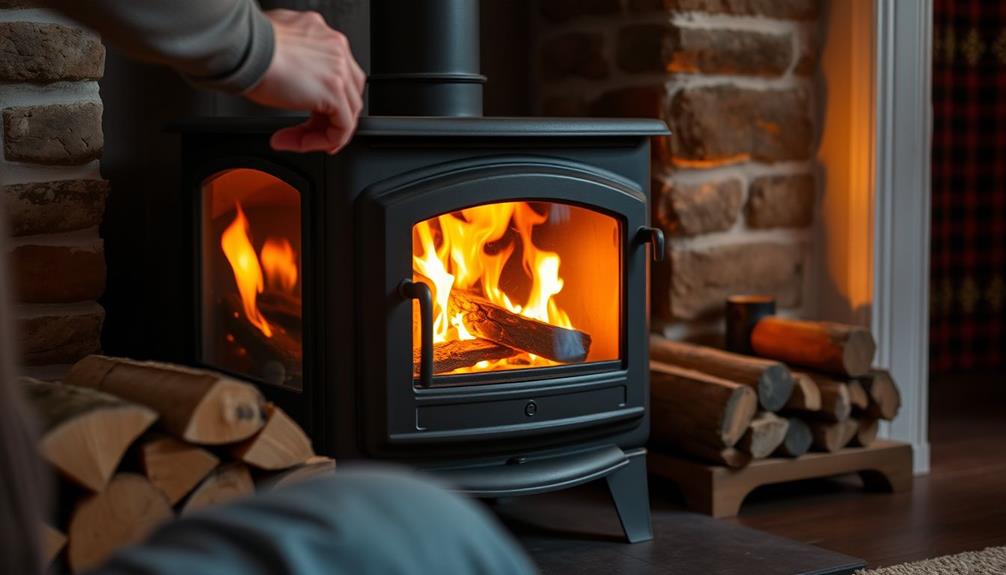
To achieve ideal heat from your wood stove, it's crucial to master a few effective operating techniques. Start your fire using small kindling and the top-down method. This approach not only creates a longer burn but also minimizes smoke, enhancing the overall cottagecore home office ambiance.
Verify that the combustion zone maintains a minimum temperature of 600°C (1,100°F) to prevent smoldering.
When igniting the fire, open all air intake valves fully to maximize oxygen flow. Once the fire is well-established, gradually reduce the air supply to maintain an efficient burn rate.
Always use dry wood with a moisture content below 20%. Properly seasoned wood provides up to 12% more energy than fresh-cut wood, enhancing combustion efficiency.
Keep an eye on the flame behavior and adjust the air controls as needed. Higher combustion temperatures greatly reduce emissions of harmful volatile compounds.
Limit the number of logs you add at a time to five. This helps prevent smothering the fire. Place the larger pieces at the bottom and smaller ones on top for ideal airflow, confirming your wood stove operates efficiently and effectively.
Maintenance and Cleaning Practices
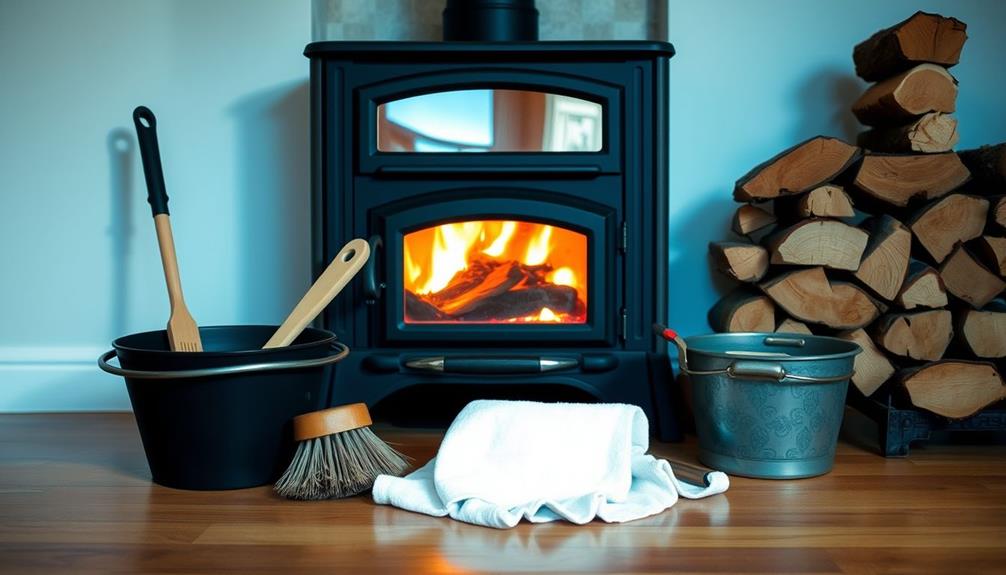
Regular maintenance and cleaning practices are essential for keeping your wood stove operating safely and efficiently. Start by inspecting and cleaning the chimney at least once a year to prevent creosote buildup, which can lead to dangerous chimney fires.
After each use, remove ash buildup from the firebox to maintain proper airflow and improve combustion efficiency; however, leave a one-inch layer for insulation. To further enhance air quality in your home during wood burning, consider using an ozone air purifier to eliminate any lingering smoke odors and allergens.
Scrub the firebox weekly to eliminate soot and residue, guaranteeing your stove performs at peak performance. Pay attention to the type of wood you're burning; using only properly dried wood with less than 20% moisture content reduces smoke and creosote production, contributing to a cleaner burn.
Additionally, keep flammable materials at least 36 inches away from the stove area to minimize fire hazards.
Safety Measures for Wood Burning
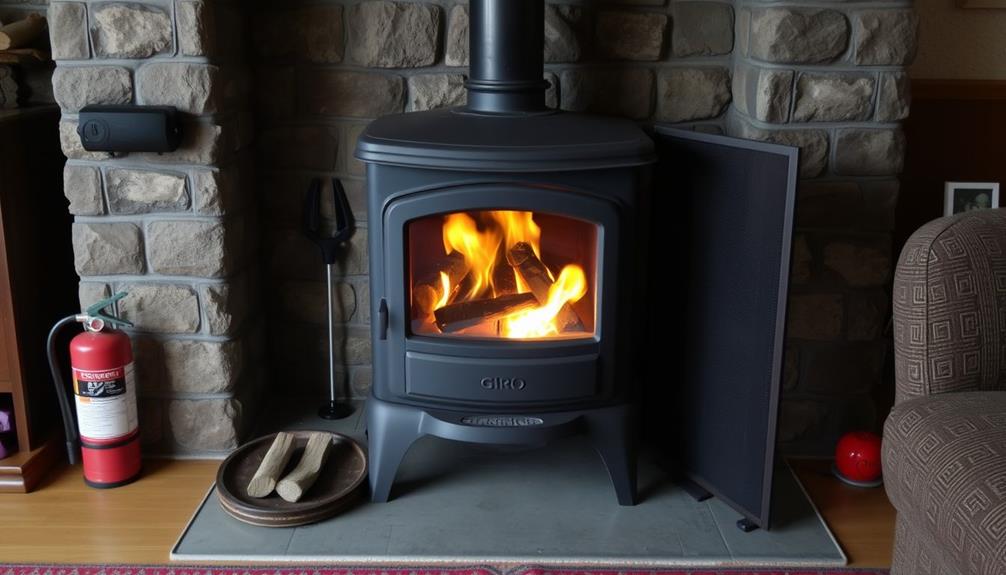
To keep everyone safe while using your wood stove, it's essential to install smoke and carbon monoxide detectors nearby.
Regular chimney inspections help prevent dangerous blockages and creosote buildup that can lead to fires.
Additionally, familiarizing yourself with dog health and nutrition can guarantee your pets are safe from common household dangers.
Staying proactive about these safety measures will assure a secure and efficient wood-burning experience.
Detector Installation Importance
Installing smoke and carbon monoxide detectors near your wood stove is vital for guaranteeing your safety. These detectors provide early detection of hazardous emissions, greatly reducing the risk of health issues and fire hazards.
Understanding the importance of safety measures is important when using wood-burning appliances. Make it a habit to test these devices monthly to verify they're functioning properly, and remember to replace the batteries at least once a year for peak performance.
When positioning smoke detectors, place them at least 10 feet away from the stove. This distance helps minimize false alarms while still keeping safety as a top priority.
Additionally, having a fire extinguisher readily accessible in the same room as your wood stove is important. It allows for an immediate response in case of an emergency, giving you peace of mind while you enjoy your wood-burning appliance.
Regular Chimney Inspections
Chimney inspections should be part of your annual maintenance routine if you're using a wood stove. Regular checks are essential for preventing creosote buildup, which can lead to dangerous chimney fires if ignored.
Proper maintenance practices can greatly enhance your wood stove's efficiency and safety. Here's why you should prioritize this task:
- A quarter-inch of creosote can restrict airflow, jeopardizing your stove's efficiency.
- Blockages or damage in the chimney flue can impede ventilation, increasing the risk of smoke and harmful gases entering your home.
- Installing a chimney cap can keep debris, animals, and moisture out, enhancing both safety and performance.
Schedule a professional chimney sweep at least once a year to guarantee thorough chimney maintenance. During the inspection, they'll check for any blockages and clean out soot and creosote, keeping your chimney in top shape.
Following local regulations regarding chimney inspections not only guarantees compliance but also contributes to safe wood-burning practices. By being proactive and diligent with your chimney checks, you can enjoy the warmth of your wood stove while minimizing risks.
Don't overlook this essential safety measure!
Environmental Impact and Regulations
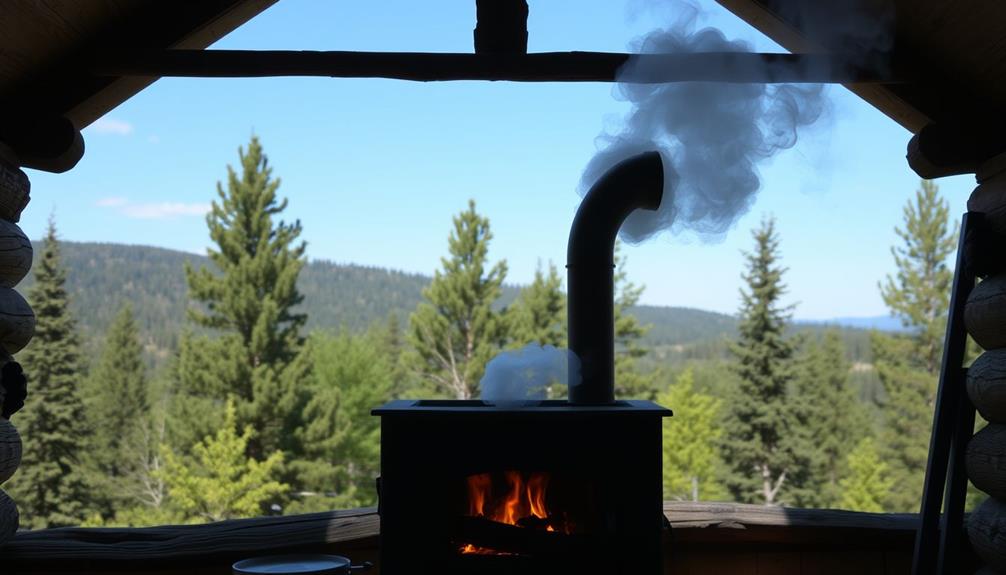
When using a wood stove, you need to be mindful of emission standards and sustainable wood sourcing.
Gold IRAs provide a hedge against inflation while also guaranteeing that your investment is environmentally conscious.
By choosing high-efficiency stoves and following local regulations, you can greatly reduce your environmental impact.
Staying informed about these guidelines guarantees you're not only compliant but also contributing to cleaner air and a healthier planet.
Emission Standards Compliance
Ensuring compliance with emission standards is essential for anyone using a wood stove, as it directly impacts both air quality and regulatory adherence. By following these guidelines, you'll not only contribute to a cleaner environment but also avoid potential fines or penalties.
Additionally, similar to how diversifying investments can mitigate risk in retirement portfolios, utilizing modern wood burning technologies can considerably reduce emissions by up to 90% potential tax advantages associated with IRA accounts. The EPA mandates a particulate matter emission limit of 4.5 grams per hour for non-catalytic models. Local burning regulations may restrict the types of wood you can use.
In the UK, new regulations require that wood stoves comply with strict environmental standards to curb air pollution. This makes choosing a modern wood stove vital for achieving compliance. Not only do these stoves produce fewer emissions, but they also help improve overall air quality.
Additionally, if you live in a region with specific burning regulations, make sure to understand what's allowed. This includes knowing which types of wood are acceptable and how to operate your stove efficiently.
If your stove is in a listed building, be prepared to navigate additional regulatory complexities. Staying informed and compliant will enhance your wood-burning experience while protecting the environment.
Sustainable Wood Sourcing
Sourcing sustainable wood for your stove is essential for both environmental impact and compliance with regulations. By sourcing firewood from local, sustainably managed forests, you help reduce carbon footprints and promote ecological balance. Using seasoned wood with a moisture content below 20% not only aligns with Pennsylvania's regulations but also enhances combustion efficiency and minimizes harmful emissions.
Here's a simple comparison to evaluate:
| Sustainable Practices | Unsustainable Practices |
|---|---|
| Sourcing from local forests | Sourcing from deforested areas |
| Using seasoned wood | Burning treated or painted wood |
| Complying with local regulations | Ignoring local burning regulations |
Engaging with local wood-burning communities can offer valuable insights into sustainable wood sourcing. This helps you stay informed about local burning regulations and the best practices for responsible wood heating. Remember, using firewood from your property can enhance sustainability and increase your property value while supporting local biodiversity. So, make the right choices for your stove and the environment!
Frequently Asked Questions
How to Use a Wood Stove Most Efficiently?
To use a wood stove efficiently, burn seasoned wood, maintain high temperatures, and employ the top-down method for starting fires. Clean the flue regularly and adjust air supply to optimize combustion and reduce smoke.
How to Properly Use a Wood Burning Stove?
Did you know that using seasoned wood can reduce smoke emissions by up to 80%? To properly use a wood burning stove, start with dry wood, control air flow, and monitor the flame size regularly.
Should Wood Burner Vents Be Open or Closed at Night?
You should close the wood burner vents at night. This reduces oxygen, controls the burn rate, and prolongs the fire. Just make sure to use larger logs and monitor the chimney draft to prevent backdrafts.
How to Maximize Heat From a Wood Stove?
To maximize heat from your wood stove, use seasoned wood with low moisture, maintain a high combustion temperature, start fires top-down, clean the flue regularly, and adjust air controls for ideal airflow.
Conclusion
As you gather around the flickering flames of your wood stove, you're not just warming your home; you're nurturing a connection to nature and tradition. By using seasoned wood and mastering efficient techniques, you ignite not just a fire, but a sense of comfort and sustainability. Remember, each log you feed the fire symbolizes your commitment to a warmer, greener future. Embrace these practices, and let your heart and home glow with the warmth of responsible wood burning.

